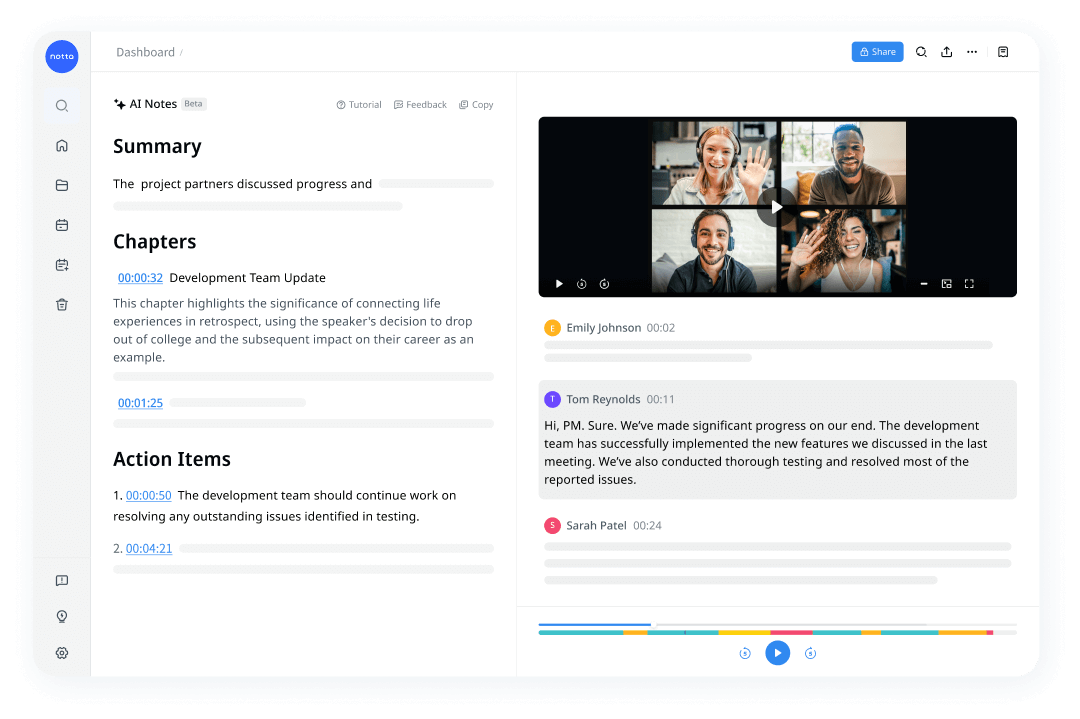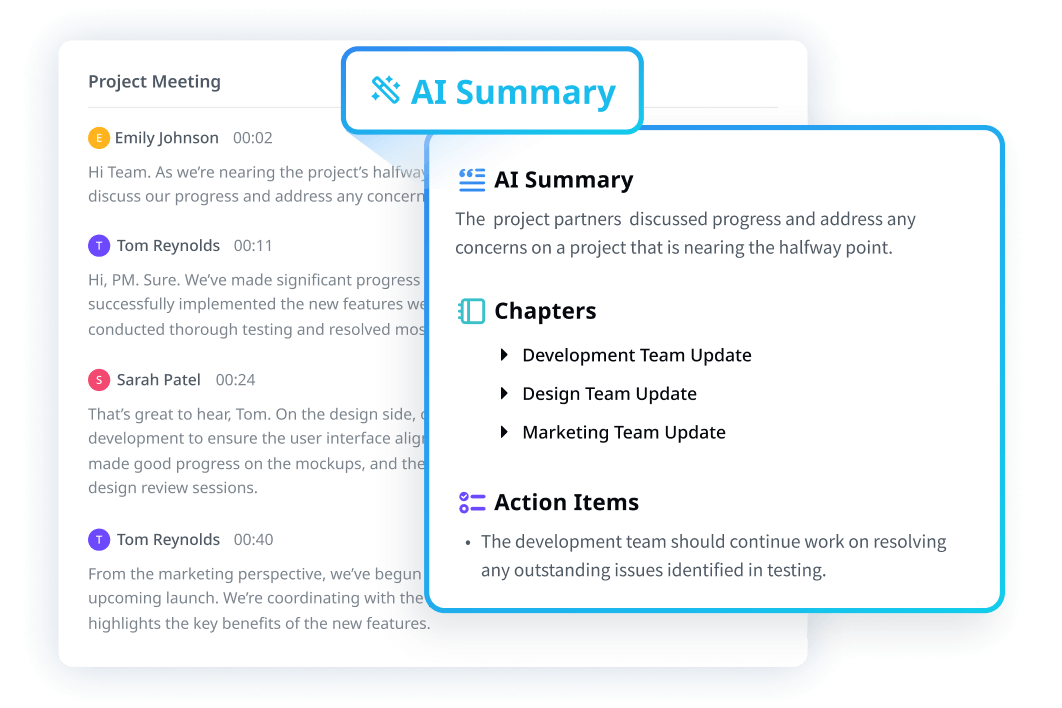
Meeting Facilitator 101: What It Is & How to Become One
Unlock the power of AI — Notta's meeting assistant records, transcribes and summarizes meeting minutes with one click.
Whether your team anticipates meetings with delight or despise largely comes down to the meeting facilitator. In other words – an efficient meeting requires a capable meeting facilitator.
Are you assigned the role of facilitator but not sure how to become one?
In this article, we’ll explore what is a meeting facilitator, its roles and responsibilities, and how to facilitate a meeting in a way that makes everyone engaged. Let’s get started!
What is a meeting facilitator?
A meeting facilitator, or meeting coordinator, is an individual who guides and oversees the meeting process to ensure its effectiveness and meaningful outcome.
They play a critical role in managing the meeting agenda, keeping the discussion focused, and ensuring that all participants have an opportunity to contribute.
The great advantage to having a meeting facilitator is that team members are allowed to concentrate on the discussion while the facilitator will manage the meeting's structure and smooth flow.
Who should facilitate meetings?
The idea of having a meeting facilitator separate from the meeting leader is that when a leader facilitates, they also tend to dominate the session. A facilitator has a more neutral role regarding the topic – they don’t even need to be experts or well-versed in what’s discussed.
More important is that the meeting facilitation is done by someone who is socially competent. This person needs to be comfortable managing the dynamics of humans with opposing opinions. So, soft skills weigh heavier than hard skills for a great meeting facilitator!
What makes a great meeting facilitator?
If you are assigned the role of meeting facilitator, below are the skills you should possess to be a great one.
Active listening
Active listening is the ability to pay attention to what others are saying and understand their perspective. A skilled meeting facilitator should be an active listener to ensure that all participants feel heard and valued. By listening actively, the facilitator can identify and address any concerns or issues that may arise during the meeting.
Communication skills
Effective communication is essential for any successful meeting. A skilled facilitator should be able to communicate clearly and concisely to ensure that all participants understand the meeting's purpose, agenda, and goals. The facilitator should also be able to encourage open communication and dialogue among participants.
Time management
The facilitator should ensure that the meeting starts and ends on time and that each agenda item is given the appropriate amount of time. This skill helps to keep the meeting on track and ensures that all participants can contribute to the discussion.
Meanwhile, they should retain some flexibility to adjust the agenda as needed and accommodate unexpected issues.
Conflict resolution
Don’t be afraid of conflict, instead, effectively manage it.
When there is a disagreement, the facilitator should remain impartial and help participants find a solution that works for everyone. Remember, don’t let the meeting deviate from its goals.
10 tips: How to facilitate a meeting successfully
So what is the flow of successfully facilitating a meeting? Before the meeting, the work falls mainly on the meeting leader. The leader is responsible for deciding whether the meeting is needed, scheduling it, and inviting the right people. They are the subject matter experts.
The meeting facilitator needs to read through the agenda to understand where you’re heading and the purpose and desired outcome of your getting together.
As the facilitator, you’re closer to the moderator of a debate or the leader of a talk show. You step into the limelight as the meeting starts and everybody is there. And here’s how you’ll do it successfully.
1. Prepare an agenda
Before the meeting, create a clear and concise agenda outlining the topics to be discussed, along with the allotted time for each item.
Then share the agenda with the participants in advance, so they can come prepared and know what to expect. And if anything changes, ensure to update the meeting agenda.
2. Assign roles for increased engagement
The meeting should start by assigning a note-taker to ensure you get all the genius ideas and decisions on paper. Alternatively, you can choose to have rotating minute-takers for each time.
Tip: In case you don’t have a note-taker or want to ensure the accuracy of your meeting minutes, I recommend using Notta AI to automatically transcribe the conversations, which can be reviewed, shared, and exported for easy access.

If applicable, you can also select a timekeeper whose sole responsibility is guaranteeing you’re on time. Involving participants contributes to the communal feeling that the meeting is for everyone – not just you and the meeting leader conveying information.
And if you want to increase the collaborative aspect further, you can get even more granular and assign everybody a different task. Or make a shared PowerPoint presentation where everyone gets to present one slide each. This is also a good hack if you experience low motivation during meetings – expanding and focusing on what you want to see rather than what you don’t want to see.
Notta offers the most integrated AI meeting notes, summaries, and action items so nothing gets missed.
3. Kick-off with icebreakers
How’s everyone doing? What’s the general mood? Tired from just having finished a project, stressed over new requirements, excited over a new milestone? Addressing the collective state of mind helps create rapport and makes everyone feel seen from the moment the meeting starts.
You can also ask a simple question like what everyone did last weekend. Allow people to chat for a moment before diving into the meat of the meeting. This is particularly important if you’re working remotely and people may not even have met in person.
4. State the desired outcome
A good meeting starts with everyone understanding why they’re even there. Even if it’s your weekly team meeting, remember to repeat the outcome – especially if you have new employees on the team or someone who’s not usually participating. It’s easier to stay focused once you get the context.
To put it simply: you need to state what a successful meeting outcome looks like.
If it feels relevant, for example, meeting with a new constellation of people, it may be a good idea to state the house rules too. Examples could be: not interrupting, having the camera on, and saying goodbye before you leave. All this to increase engagement and the human connection.
5. Review last week’s action iItems
Time to get the party started! Where did you leave off last time? What has been done? Has something been overlooked, and if so, why? Reviewing tasks from the previous meeting helps identify bottlenecks in processes and how you can reallocate resources for better results.
Knowing that you’ll go through last week’s assignments also entices meeting attendees to come well-prepared. It can also encourage better time management.
6. Practice active listening
As the great meeting facilitator you are, you don’t only have the technical skills down– but also the soft skills. Active listening is one of the most pertinent capabilities of a facilitator. No one likes talking to someone who looks bored and is just waiting for the other to stop.
Active listening can come in the form of body language/non-verbal cues. This can look like having an open and inviting body language (such as not crossing your arms), nodding, smiling, and keeping eye contact with the speaker. Another example is patience: not rushing the participants to finish their sentences but leaving space for silence and contemplation.
Keep these steps in mind during the meeting:
Connect. Connect to the speaker by making eye contact and listening attentively.
Reflect. Reflect to the participants what they just said.
Correct? Ask them if your reflection was accurate or if you misunderstood something. Anyone can misinterpret – but the sooner you can detect and course correct, the better.
Remaining neutral and non-judgmental is also essential for a good meeting facilitator.
As the above steps show, a part of being an active listener is to reflect back the general message to the interlocutors. It’s thus a good idea to wrap up the meeting by summarizing what has been said.
7. Balance engagement
We’re all beautifully different. As the meeting facilitator, it is your job to realize that every attendee has excellent ideas – but not everyone is comfortable conveying them in front of the others. Some people will naturally take up space and talk during meetings, while others tend to disappear in group settings.
While you can’t oblige anyone to talk, make sure to create space and show them their opinion is valuable. You can also clearly state that they can send you a message or speak with you privately if they don’t feel like sharing in front of everyone.
On the other hand, people who talk a lot can also ignite the discussion and inspire others to follow. Show your appreciation and consider assigning them a role within the meeting (or company) where they can leverage their vocal gifts.
Another way to balance participation is to create break-out rooms (if the meeting is on Zoom) or smaller groups. That way, participants can discuss in a more intimate setting before sharing their insights with everyone.
8. Manage meeting energy
Is the meeting about to go over time? Does everyone seem a little extra tired? Have you just had tight deadlines or launches? A good meeting facilitator can feel into the group’s energy like a DJ feels their audience and decide when it’s time to take a break or finish.
Energy is contagious – even virtually. It can often be more efficient to stop and save the less urgent points for next time than to keep going when everyone has zoned out and secretly scrolls for their next vacation. You can also consider adding a follow-up meeting the next day,
During an in-person meeting, a way of increasing the energy levels can be to get participants up to write on a whiteboard. Online, you can have everyone stand up and do simple movements like shoulder rolls or breathing exercises. Depending on the culture at your company, you can even put on a song and have everyone dance (optional: with their cameras on).
9. Wrap it up
Any successful meeting comes with a sense of closure.
For each agenda item, summarize the key points discussed to ensure that decisions are accurately captured. Additionally, recap the main takeaways and the date for the next meeting (if applicable) at the end of the meeting, highlighting any action items with the deadline.
Ensure everything is clear and let the participants know they can reach out to you with any questions.
Tip: If you have used Notta to take automated meeting notes, this AI-powered tool will also generate a comprehensive meeting summary including key takeaways and next steps, saving you hours of time and making follow-up easier.

10. Share the meeting notes
Depending on how you have allocated the roles, this task may or may not be on the meeting facilitator. True knowledge comes from repetition – by being able to look back at the meeting minutes, participants will retain the information better.
Summing it up
Facilitating a meeting requires both art and science. Art as in feeling the group energy and managing who speaks when. Science as in getting the technical parts down – like assigning a note-taker and sharing the notes afterward.
Becoming a great meeting facilitator gets easier with practice. So don’t be too hard on yourself. Following these tips already takes you far. The reward is more engaged employees and thus higher work performance – and what can be more worth it?